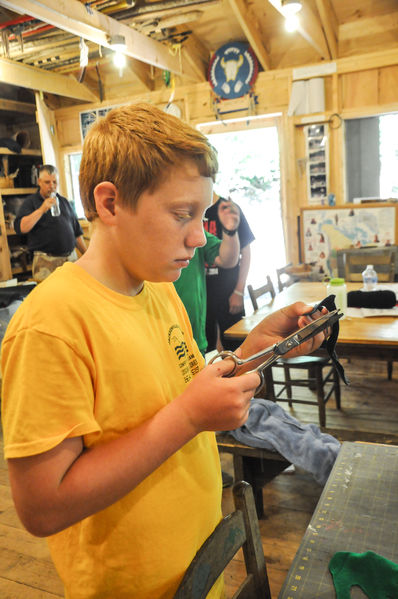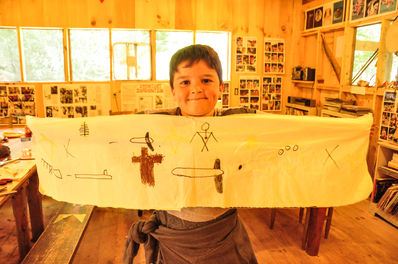Jim Talks (Part 2)

Jim Kurtts Talks Falling Creek And Personal History
John Granatino
A few weeks ago, we did an interview with Jim Kurtts, camp’s longest returning staff-man. He had a lot to say about early camp and his contributions to the Indian Lore program. But we wanted to hear more about his personal history and memories about camp. So I went in for another interview to learn about his experience with the tribes of the mid-1900’s.
“I grew up in South Alabama, where the local Indian tribes, the Creeks, were taking the Federal Government to court,” he says as he sits in his Indian lodge on the edge of camp, helping campers bead chokers and stitch costume parts. He’s preparing for the upcoming Grand Council, a Native-American Drama that he modeled after the Indians of the Southeast.

Jim joined the Order of the Arrow(OA) as a Boy Scout, a camping group based on Native American traditions organized like a tribe. He found an appreciation for the culture before the political correctness in America would have normally allowed him to do so. The World War II generation of people rebelled against any tie with Indian culture. These sentiments didn’t change until the 1970’s.
“They had not identified themselves as Indians because of racial laws and segregation. If they had said that they were Indian, then they would have had to go to segregated schools… They didn’t have reservations and had supposedly been absorbed into white society and didn’t exist.”

About the time the tribes were able to admit their own existence, Jim followed the remaining people out to Oklahoma, where they still conducted traditional dances and performed pow-wows. There he discovered the modern Indian that would inspire him for years to come. A living culture, the Indians showed off their comfort in using modern conveniences like vibrant color dyes in feathers and sunglasses to block their eyes from the sun.
“I came back to compete in an Order of the Arrow event with an outfit that was turquoise and hot pink and wearing sun glasses… Some of the old-time Order of the Arrow guys [said], ’Where did Indians get all those colored feathers?!”
The OA participants at the time followed the Ben Hunt tradition of costume building. They believed everything had to either be real, or look real. So if they couldn’t find real deer antlers they would make some out of wood or use brown-colored fabric instead of leather. Jim remembers answering them, “Well, feathers can be dyed.”
When they asked, “Well, where did Indians get sun glasses?’ he said, “Just like me, they went to the Otasco.”

Jim claims to always keep a modern frame of mind when coming up with the Falling Creek program. “Indians are still out there dancing. Indians are still out there doing bead work. They are still out there involved in their culture. It’s not a dead culture.”
He had such a close tie with the native people, he reflects on visits he used to make when he organized trips to Unto These Hills.
“In the early years of camp, the whole camp would go to Cherokee… which meant they would bring three big busses up. We would load up the whole camp. All 100 or 150 of us (however many in camp). We would all go to Cherokee and watch the drama— the Unto These Hills drama— and then come back to camp really late… I remember that some of the Cabin 1 boys and Cabin 2 boys would have to carried back to their cabins because you couldn’t wake them up.

He also recalls visiting Cherokee land on the Fourth of July for pow-wows and Oconaluftee to see traditional crafting and activities that has remained true to the times.
While they no longer attend these events off-campus, he has still done his part to maintain the quality of the program. Just last week, he made the 2 and a half hour drive out to Cherokee to make bean bread. A couple days later, he made the same bean bread at camp with his campers.
The part of the program he has used to stay true to the activities origins has been Grand Council at the end of Main Camp. It highlights the camps dancing, singing and costuming all in one night. “When you prepare for Grand Council, you learn the songs, you learn the dances, you learn the outfitting, you learn the ‘whys’ and ‘wherefores’ of the Native Indian culture… It’s like if you were doing a play on Elizabethan England, like Shakespeare. You would have to learn the lifestyle of the people. And you would do the costuming so you would look Elizabethan, and everything to get to a Shakespeare play.”
With the event coming up this Wednesday, Jim goes back to work on the costumes and beading, hoping to continue the tradition of his own tribe.